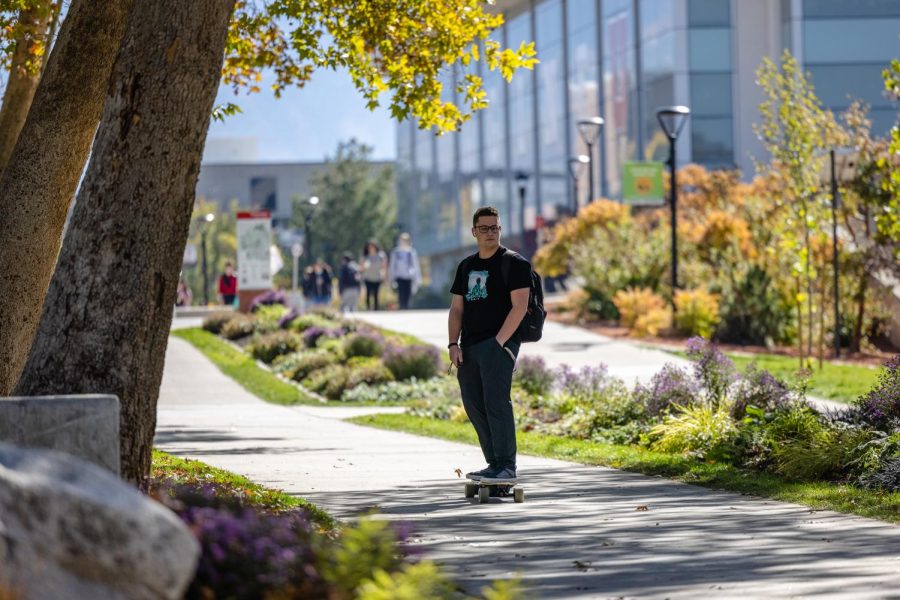Transportation Safety on Campus for ‘Walking, Rolling and Riding’
A student who rides a skateboard in the campus of University of Utah in Salt Lake City, Utah, on October 21st, 2021. (Photo by Xiangyao “Axe” Tang | The Daily Utah Chronicle)
November 11, 2021
The University of Utah’s campus is full of bike paths, bike racks and students carrying their skateboards into classes. While the U allows students to take advantage of their favorite means of transportation for traveling on campus, whether that is a bicycle, motorized scooter, roller skates or skateboard, they also have safety guidelines for them to follow.
Ginger Cannon, the Active Transportation Manager on campus, has advice for people riding bikes on campus.
“Make sure to lock your bike, remember that there is a speed limit of 10 miles per hour on campus paths and give pedestrians the right of way,” Cannon said.
There are over 3,000 bicycle spaces on campus to lock up bikes. Bikes are not allowed to be chained up to things besides a bike rack on campus. Additional information about the biking policy can be found online.
Bikes are encouraged even during the winter months and there is even a Winter Bike Day. It is usually held in February and offers giveaways and hot drinks to those who participate.
”It is important to point out that sidewalks are for pedestrian use, and any vehicle on a sidewalk needs a permit, must go 5 miles per hour or less, yield to all pedestrians and bikers and have flashers on when driving,” Cannon said.
These speed limits and rules also apply to all golf carts, according to University policy.
Designated routes for different wheeled vehicles, as well as parking, can be found on the online campus map.
There are several bike repair stations strewn throughout the main campus, where riders can fix their bikes free of charge using provided tools.
There is also the Campus Bike Shop, located across from the Utah Museum of Fine Arts at 413 Central Campus Drive. They offer “repair and maintenance services at affordable prices to students, faculty and staff members.”
To promote further safety for riders and pedestrians, all wheeled vehicle riders are recommended to wear a helmet and use appropriate hand signals to ease up any confusion.
“A large problem on campus paths and sidewalks is excessive speed and many pedestrians have been seriously injured due to irresponsible behavior of drivers, cyclists, skateboarders and scooter riders,” Cannon said.
Campus Policy 3-232 talks about safety and rules for all who are walking, rolling and riding on campus. The policy states certain parts of campus prohibit riding in heavily trafficked areas, especially where pedestrians are, and riders are required to dismount, carrying or walking their means of transportation safely.
The policy also warns against scootering and skating in areas that are not meant for that purpose.
“Non-motorized riding devices, of any type, shall not be ridden upon any stairway, wall, bench, fountain, or other structure or facility or on or over landscaping, shrubbery, grass or flower bed,” the policy states.
In addition to having the policies of wheeled vehicles, the Commuter Services website contains insights about other facets of traveling on campus. Pedestrian safety, car parking and payment, Saferide, parking permits and other options can be found there.
These policies are in place to keep students safe when walking on the sidewalk and traveling to classes. Cannon explained that the policies are majorly unknown to students, and urges them to check the student handbook for more information.
“We do everything we can to communicate with them in orientation and through enforcement,” she said.
Students often practice skateboarding on campus. One that asked to remain anonymous was skateboarding with some friends near the Marriott Library. He said he was “unaware that it even existed” when talking about Policy 3-232 and other safety measures for skateboarders.
The male student and his friends were not wearing helmets, and were engaging in several advanced tricks. He said that he was not wearing a helmet because he “doesn’t own one.”









